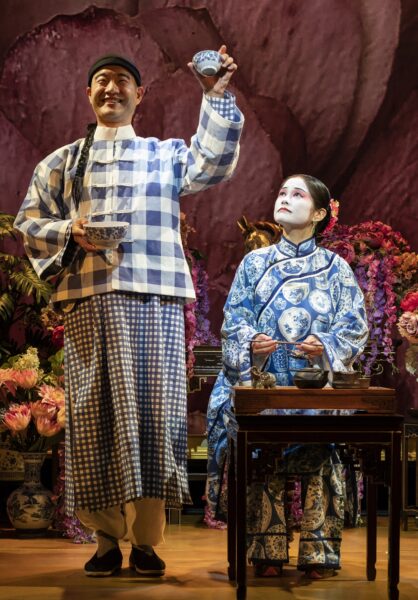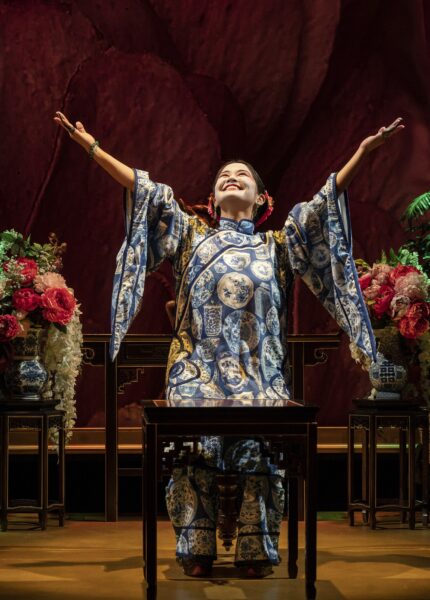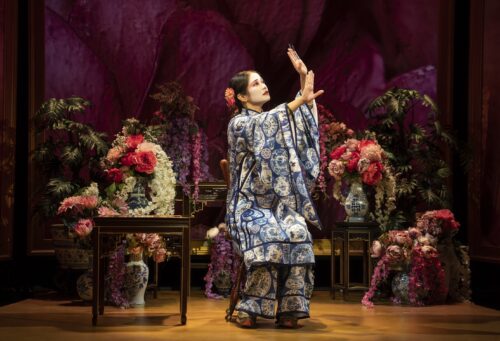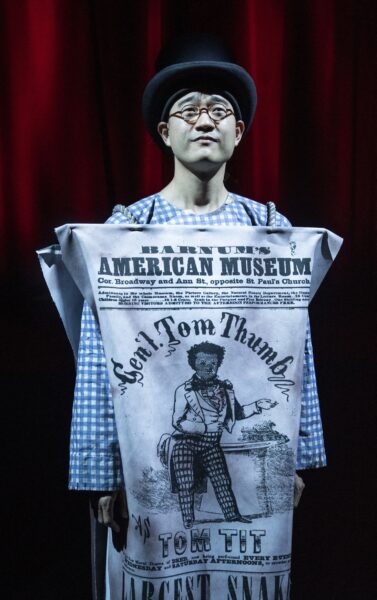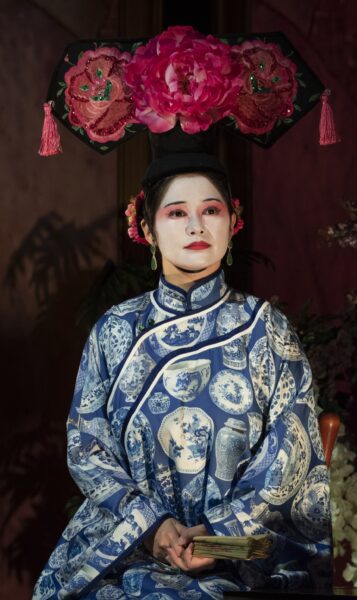DECORATIVE CHINA
Immediately upon entering The Shiva Theater within The Public Theater building, the audience for The Chinese Lady is greeted with an onstage shipping container that fills the playing space. It is a bit off-putting but mostly curious. And, as it turns out, a perfect image to start playwright Lloyd Suh’s exploration of the life of human object on display, Afong Moy. The production is at once beautiful and horrific, entertaining and disturbing. Under Ralph B. Peña’s eagle-eyed direction, the show soon expands with Moy’s life becoming an allegory for the Chinese immigrant experience in America — an experience that includes fascination, commodification, invisibility, dehumanization and violence.
In 1834 while still just a sheltered, privileged teenager in the Canton region of China, Afong Moy’s upper-class father sold her to two American businessmen/exhibitors, the Carnes Brothers, for a duration of two years. The actual reasons are unclear but Afong seemed to believe she was in America to help foster mutual understanding between China and America. The Carnes Brothers interest was to display Afong as a curiosity because of her Chinese heritage and, especially, her bound feet. Foot binding, once expected for upper-class Chinese women, was a process whereby a young girl’s feet were repeatedly broken then wrapped in cloth, with the front foot bent under the sole. The result being that by adulthood, the young woman’s feet would be just a few inches long, a cultural sign of beauty in that period.
Only fourteen years old upon arrival in New York, Moy was a national sensation within a few months of being on display. Hence the pre-show image because when the container is opened as the play begins, the cargo inside is Moy herself. She sits in the center of a beautifully appointed, if not completely authentic, three sided Chinese-decorated room/display. The fourth side of her space is open, allowing us to see her and her to see us. She sits. She walks. She sings. She pours tea. She speaks directly to us. All while wearing beautiful Chinese dress. All while speaking running commentary, as Suh’s words often highlight the contradictions, imbalances and suffering behind the display. And point out that, due to manipulation by the Carnes Brothers, Afong never saw China or her family again.
There are only two characters in this performance and the writing itself is very much of twenty-first-century America. Suh’s words can be funny, sly, thoughtful, even snarky — allowing the actors to examine their difficult situation from a modern sensibility. The very talented Shannon Tyo wonderfully brings Afong Moy to life.
Ms. Tyo believably ages Afong from a naïve, excited teenager to a disappointed, hardened, much older adult. This actress fully embraces the expanse of Afong’s emotional journey and undergirds her portrayal with a rich, deep, effecting humanity. It is heart breaking when Ms. Tyo begins to realize that, perhaps, she is just another object on display. It’s also disturbing for audience members to realize our viewing makes us complicit in her dehumanization.
Daniel K. Isaac portrays the other character, Atung. As Afong’s translator (she doesn’t speak English) and de facto caretaker, Isaac is hilarious, moving and somewhat depressing. His is the life unlived, a reality that Atung made peace with long before meeting Afong. With a constant smile on his face that is rarely indicative of what he’s actually feeling, Isaac excels in portraying this guarded man whose existence has been reduced to function. And, he makes us, as viewers, reflect on who we see when we see immigrants, if we see them at all.
Jiyoun Chang and Elizabeth Mak‘s gorgeous, co-lighting design does more than illuminate; it dances and communicates. When met with Shawn Duan’s compelling screen projections, the combination helps bridge the audience from today to the Chinese experience in America. When Ms. Tyo as Afong Moy shows up in 2022 (yes, somehow she’s still alive), she dismays at the rise in Anti-Asian violence. We dismay to see how long that violence has actually existed. Oddly, this very precise production does get a bit unwieldy in this last section — with Suh in effect switching from Afong’s voice to his own. However, in a life or death situation, perhaps a switch in tone is needed to signal the urgency of the message.
The Chinese Lady directly challenges us to interrogate how we see. But it does so in an entertaining, thought-provoking, mostly indirect way. Yet the point is clear. If one has the opportunity to meet this Lady, don’t just look at her. See.
photos of Daniel K. Isaac and Shannon Tyo by Joan Marcus
The Chinese Lady
The Barrington Stage Company and Ma-Yi Theater Company
The Public Theater, 425 Lafayette Street
Tues-Sun at 8; Sat at 2 | ends on March 27, 2022
for tickets, call 212.967.7555 or visit The Public
Alternates Jon Norman Schneider and Cindy Im will go on March 12 at 2; March 13, 15, 22 at 8
Ms. Im performs with Mr. Isaac on March 19 at 8
Mr. Schneider performs with Ms Tyo on March 26 at 2

